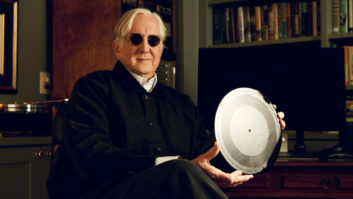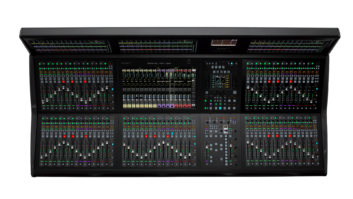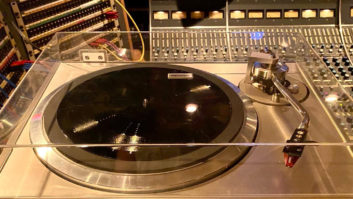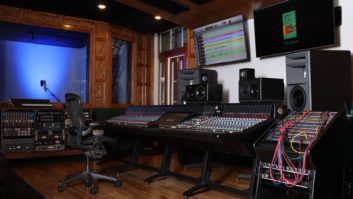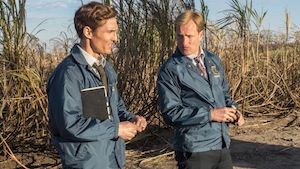
Photo: Jim Bridges/HBO
It’s been awhile since the ending of a season of a limited TV series has been mourned as widely and intensely as HBO’s True Detective, which capped its remarkable first-year story arc in March. Here’s an example of a show where saying that it’s about two Louisiana detectives trying to solve the ritual murder of young woman doesn’t begin to hint at the depth and complexity of creator/writer Nic Pizzolatto’s eight-hour story—the way it seamlessly jumps back and forth between three eras over 17 years, involves dozens of truly odd, idiosyncratic, but strangely real characters, and uses creepy and lonesome rural Louisiana settings to create one of the most haunting backdrops for a story you’ll ever find.
The acting is otherworldly good—it will be shocking if both Matthew McConaughey and Woody Harrelson, as the troubled and temperamentally mismatched detectives on the case, are not nominated for Emmys; neither has been better or more riveting. And the large support cast of cops, family members, girlfriends, bikers, hookers, religious zealots and assorted strangelings is perfect, too. The direction by Cary Fukunaga is imaginative and beautifully paced, Adam Arkapaw’s cinematography is striking and artful, and Pizzolatto’s character-driven writing—which is truly the backbone of the show—challenges the viewer at every turn, mixing arcane references, unusual philosophical ramblings and plenty of down-home local color.
And then there’s the music, which is almost like another character—or a whole bunch of characters—in season one. Pizzolatto could not have made a better choice to helm the music: Producer/musician/songwriter T Bone Burnett has long been one of the pre-eminent executive music producers (or “curators,” as he calls them) in film, an artist with an encyclopedic knowledge of American roots music, R&B, gospel, old and new rock and much more, and equipped with an innate sense of how to employ those styles in the service of visual storytelling. In the film world, he’s perhaps best-known for the work he’s done on the Coen Brothers’ films O Brother Where Art Thou (which earned him five Grammys in 2002, including Producer of the Year) and last year’s Inside Llewyn Davis, and for his songwriting contributions to films such as Cold Mountain and Crazy Heart (which won him an Oscar). He was also executive music producer for season one of the acclaimed TV series Nashville.
But it’s safe to say that Burnett has rarely faced a task quite as involving and all-encompassing as his work on True Detective. Not only did he select each of the more than four-dozen cool tracks by other artists that lace through the series—he was also responsible for the eerie and evocative original music. T Bone’s score subtly employs a wide range of dark synth tones, pulses, bursts of percussion, peculiar melodic fragments, and sparingly used instruments—from drums to horns to didgeridoo—often to purposely unsettling effect. He also contributed two original songs—one co-written with Cassandra Wilson called “Sign of the Judgment” (based on an old gospel tune), and “The Angry River,” which plays under the end titles of the final episode and features Father John Misty and S.I. Istwa.
“Scoring is something I’ve wanted to do for a long time,” T Bone says in mid-February, the day after the final post work on Episode 8 had been completed. “I started out doing electronic music back in the ’60s, and I’ve always loved that stuff. But there was never really the opportunity for me to do it, and I certainly wasn’t going to try to make a straight-up techno/electronica record or anything like that. That would’ve been ridiculous. But for this material, it was completely appropriate to go to that place. I’ve been getting more and more into scoring in the last two to three years and I’ve come to an understanding of it, really. Working with Danny Elfman has been my master’s class in scoring. He’s so brilliant in his approach.”
It was Pizzolatto himself who requested that T Bone be brought on board to handle the music on True Detective, “and it makes sense,” Burnett says. “We’re simpatico. We’re very much writing about the same things—self-delusion, corruption, all that stuff.”
What was the agreed upon approach to the original score? “The first thing that happened is, since this piece has a beginning, a middle and an end, we talked about approaching it as an eight-hour movie, and having it be a movie score. So I wrote a scene, but [that music] doesn’t actually appear in full until the eighth episode. But all the music that happens until the eighth episode is drawn from that theme. I wrote a set of intervals that could be broken down into many different configurations, so the DNA of the melody is in all of the music. Parts of it will appear in a scene, and another one comes over here, but in the end, the whole thing is revealed.
“So the first thing I really did was write a standard, big-time epic movie melody. I started from that place. I went to the climax of the movie and wrote the melody for that and then worked backwards. The original thing was these two four-note melodies, and there are certain intervals that fit together in a certain way. If you take the two four-note melodies and put them together as a puzzle, it creates an extraordinary cluster—a beautiful, tight cluster. That cluster became the tonality and the over-tonality of the whole piece.”
Most of the scoring work was done at Burnett’s Electromagnetic Studio in L.A., with one of his longtime engineers, Jason Wormer, handling the technical end, but also deeply involved creatively—collating and arranging the music, with T Bone’s oversight, and also acting as the primary liaison with the show’s music editor, Shari Johanson, who was in contact with re-recording mixers Leslie Shatz (who mixed a few episodes in L.A.) and Martin Czembor (who worked out of New York).
“It’s almost all synthesizers,” T Bone says of the score, “and I’m playing a lot of them. Here’s the band: Keefus Green [aka Keefus Ciancia] has been playing piano and synthesizer for me for many years; he’s incredible! Darrell Leonard played horns and synth EVI and didgeridoo. And Patrick Warren played Mellotron and various electronic instruments. We’re all playing electronic instruments or samples, and we’re using our own samples.”

T Bone Burnett
Photo: Lester Cohen
“Patrick owns a library of all the original Chamberlin tapes, and he also does a lot of bowed metals and hurdy-gurdy,” Wormer adds. “That’s sort of Patrick’s field—Dulcitone, Celeste—those kind of slightly more identifiable sounds.
“As for Keefus, I honestly don’t know what some of the sounds are. I’ll [email him] and say, ‘What the hell is a harp-piano?’ and he’ll write back, ‘Yes!’ He has a lot of weird prepared piano sounds, weird string sounds—not your typical Kontakt laid-out [string library] cello, but a cello playing a weird melody he’s pitched down three octaves and flipped it backwards.
“So, Patrick is filling in a lot of the melodic stuff, and Keefus is doing a lot of the weird, creepy stuff. Then Darrell is the winds guy: He does a lot of brass—things like bass trumpet—and then he also does a lot of didgeridoo. He uses a conch shell a lot. He also has a thing called a Kahn, which I’ve yet to see, but there are pictures of it online. It’s this odd thing with pipes sticking out of the top of it, but it makes this really distinct sound. You hear it and you think, ‘What the hell is that?’”
T Bone’s main session drummer, Jay Bellerose, contributed most of the powerful percussion elements, either live (recorded at the Village) or through drum samples he’s made the past few years. Many/most of them have been altered in some way, in keeping with the bizarre textural ambience. T Bone also plays atmospheric guitar here and there. The music is recorded to Pro Tools through the studio’s API console.
On a typical episode, Wormer says, “T Bone and I will sit down and watch the whole episode with Nic, the creator, and Scott Stephens, the executive producer, and we take notes on what they want to happen. Then we sit down with T Bone and pick some tempos and put either some drums or pulses in. This score is pretty Moog-heavy, so we’ll do some Moog stuff to get a backbone laid out. Then, depending on whether Keefus or Patrick or Darrell is around, usually I send that out to them and let them do their own thing, and they all keep in contact with each other. We send everything to everybody and they all get a shot at it, in terms of what they want to add to it. But everybody always knows what everyone else is doing. Everyone has his own aesthetic and the range they take up. So if Keefus gets something, and T Bone and I have already put some drums or some guitar or a melody thing on, Keefus knows that Darrell is going to put some solo brass to cover one area, and Patrick might do the high stuff, so Keefus might just do a little accent work on it. Or vice-versa.”
And then you just pick and choose what you want, without regard to their feelings? “Right!” he laughs. “T Bone has this whole philosophy that it’s not ‘my part,’ it’s not ‘your part,’ it’s just ‘a part.’ Everybody’s part is equal and doesn’t belong to any one person.
“It’s an interesting palette of sounds. The brass stuff sometimes has didgeridoos behind it, so it’s sort aboriginal noir. There are so many things that aren’t really identifiable.”
And that lack of specificity and definition is part of what gives the music its mysterious cumulative power, so apt for a series filled with scenes of underlying or actual tension, grim portent and outright dread. Sometimes, as viewers, we feel the music more than we hear it, as if it’s an organic part of the soundscape. There are certainly big musical moments, too—Episode 8 is nearly wall-to-wall score, much of it abstract and edgy, used brilliantly to ratchet up the almost unbearable suspense. But the music is never showy or intrusive. It’s there, T Bone says, to serve the story and the characters.
The outside songs that T Bone chose for True Detective encompass an amazing range of styles and eras, and are used both as source music (coming out of radios, playing at clubs, etc.) and also as “score.” And though he likes the songs to have some sort of thematic connection to whatever is happening in the scene—even if it’s just depicting a character’s mood—he steers clear of obvious or heavy-handed choices. So that’s why you’ll find a Waylon Jennings, Ike & Tina Turner, Emmylou Harris, Black Rebel Motorcycle Club and Richard and Linda Thompson all threading through the same episode, and in others encounter songs by the 13th Floor Elevators, Wu-Tang Clan, John Lee Hooker, Cuff the Duke, Lucinda Williams, The Kinks, Boogie Down Productions, Vashti Bunyan, Johnny Horton, Grinderman and many more. The wonderful opening credits song is “Far From Any Road” by The Handsome Family.
Interestingly, however, you won’t find much in the way of traditional Louisiana music. “One of the first things Nic said to me is, ‘I don’t want any Cajun music,’” T Bone says with a chuckle. “And Nic is from Lake Charles, so he knows this territory very deeply. But as far as the tunes go, here’s the thing: As eerie or otherworldly as the score is, I wanted the needle drops, or the source cues, to be equally as sort of displaced and disorienting. We’re treating Louisiana not as it is or was, but a Louisiana in the realm of True Detective. It’s a fictional, surreal Louisiana. We’re looking for fictional truth.”
Not surprisingly, legions of people have searched for the songs and artists they’ve heard on True Detective (tunefind.com has them broken out by episode), and T Bone sounds confident that there will be music releases of both songs and the original score to come. And, of course, the series will have an extended life on Blu-ray (T Bone was recorded for some of the commentary) and HBO’s various platforms. This season of True Detective is going to be discovered again and again for years.
What will happen next time out with True Detective is anybody’s guess, but T Bone freely admits he has the scoring bug and plans to pursue that avenue as much as possible.
“I think I’m going to spend most of my time scoring,” he says. “I’m very proud of this music. I wrote most of it, and then my guys orchestrated it, but they’re also writing, too. And we’ve started a band now called The Hat and we’re going to be a scoring band. [Their first formal credit is on “The Angry River.”] There are a lot of things our team can do that I don’t need to be there for, so I’m trying to set up a platform for our team to be able to do a lot good work in the future.”
More from T Bone Burnett and engineer Jason Wormer about creating the music for True Detective
Were all the various snippets of music done to picture specifically for those scenes, or did you create some general pieces that were chopped and dropped in where appropriate?
T Bone: No, every piece in this was hand-made for that [scene]. One of the ideas in the beginning was to do soundscapes that could then be chopped up, like you said. Trent Reznor does that [in The Social Network, et al], and brilliantly. But it just turned out, as we got into it, that the detail in the writing was so specific that we had to really follow that. Everything was written specifically for the moment. That’s not to say the same themes weren’t repeated at different points, but they weren’t lifted from one place and put in another. Actually, there may have been some horns that were lifted from here and put to there, but a whole cue wasn’t lifted.
I read that you played a synth called a Swarmatron. I gather it’s a little like a Theremin?
T Bone: It’s all based off the Theremin. Robert Moog was inspired partly by the Theremin, and there a bunch of instruments that are reactions to the Theremin. Most of the synthesizers we used on this were analog synthesizers; a lot of Moog stuff. That guy, Robert Moog, was an extraordinary genius. He made an instrument anybody could play, with built-in anomalies and stuff. It was really fun diving into that world.
Jason Wormer: [The Swarmatron] is like a Moog but with up to eight oscillators—as opposed to one or two or whatever—and it doesn’t have keys, so you don’t have pitches that you can easily replicate. It has this band that you touch and you can control the range of that band, so it can be a full-range band and when you sweep your finger across it, it can go from a very, very low note to a very, very high note, or you can limit it to be just one note.
I was trying to think about what sort of precedents are there for this kind of score, and how far back do they go? And I thought about Apocalypse Now, which had all those strange atmospherics and was also almost entirely done with synths.
T Bone: There’s some of that in there, definitely. You know, the piece we probably drew the most inspiration from was The Night of the Hunter [from 1955]. There’s a scene with a little girl and a little boy in a boat on a lake. You can probably even find that scene broken out on YouTube. [He’s right: http://www.youtube.com/watch?v=iFzTBPy7nl8] Robert Mitchum is chasing them and they get away in a boat on a lake. The score of that movie [by Walter Schumann] was part of the inspiration for what I did on True Detective.
There are songs I might not expect you.
For instance, …
The song you use in the strip club scene is by Boogie Down Productions?
T Bone: Exactly. We put [rapper] KRS-One in a strip club in 1995 Louisiana. And the thing is, he’s saying “Cocaine runs America, ganja runs America.” He’s talking about the same thing I’m talking about and Nic’s talking about. So there’s a brotherhood all saying the same thing. Someone could take exception to that choice based on “That never would have been happened.” Out of respect to KRS One, they wouldn’t want his song played in a strip club. [Laughs.] But me, out of respect to KRS One, I want his song played right now on HBO in 2014. Actually, that song came out in the ’80s and it’s completely possible that a DJ in Louisiana would’ve heard it and played it in a strip club. It’s not out of the realm of possibility. But from our standpoint, the most important thing is that’s what we wanted to talk about with the music there. In the strip club maybe we should have played Aerosmith.
Thank you for not playing Aerosmith.
T Bone: You see what I mean? Everybody can do that. And this [stripper]—I wanted to give her every bit of taste and intelligence; cunning. You try to help develop a character [through the music], rather than pour more of the same onto the character.
When you’re going through the songs that are going to be matched with scenes in the episode, are they ever rejected by others?
T Bone: No, not really.
So it’s really your call. Do you ever go through changes with them once you’ve selected them? “Maybe this isn’t the right vibe for this scene after all.”
T Bone: Well, I never say “This is it.” I say “What about this?” And I usually don’t say “What about this?” until I’ve found something that pretty much kills already. I’m not going to waste people’s time by showing them something that might work.
I also like the way the score sort of blends into FX, and sometimes you can’t tell what’s score, what’s FX, what’s Foley—the lines get blurred.
T Bone: We’re actually doing some FX. Like, we added a lot of machine effects when they’re in the office. There are noises we generated out of our machines, whether it’s just like some sort tension noise, or whatever. But also, obviously they recorded a lot on location, so there’s a tremendous amount of ambience [on the production tracks], so we were blending with the ambience a lot. We were taking the ambience we had to work with and then extending it, using that drone to our advantage.
There’s also a lot of hidden work in there. Like every one of those car drives, we put a subtle beat under it. There’s a cue that goes through the whole thing called The Beat. You hear it the first time you see him driving out to the crime scene. It’s got elements of another theme called “Psycho Sphere.” There are about five themes that are woven together in the end. But there’s The Beat that’s going through the [driving scenes] at some volume; most of the time you barely hear it because it becomes part of the sound of the car.
When you’re working on the music for an episode are the FX already in there?
Wormer: Not the finished ones, no. Usually it’s the [location] production track and some rough sound effects.
So do you have to worry about staying out of the frequency ranges of effects that are going to be added later?
Wormer: Yeah. And [Episode] 4, for instance, was particularly hard because it had a lot of motorcycles, and that whole end scene had choppers and gunshots and all this other stuff I didn’t get to hear until after the dub. So sometimes we have go back and make adjustments to our mix—“OK, now this music is being completely obliterated by the hoppers, so this needs to be louder…”
What are you actually sending to the mix stage—stems?
Wormer: Yeah, they requested stereo, so we send them stereo mixes and then stems. I do a pretty wide split [on the stems] for a lot of flexibility. For the most part, though, [the re-recording mixers] don’t go to the stems that often unless I tell them to—anything that on the day we’re recording, I think T Bone might want to change or that we might want to duck out [in the mix]. Some cues get as wide as 20 stems, to make sure we have maximum flexibility.
A lot of the power of the music is that it’s used subtly and judiciously. It kind of creeps up on you in a lot of scenes, instead of hitting you over the head, like a John Williams score. Obviously there’s less melody, but even the pulses are subtle, and I like the way sometimes there will be an irregularity to the pulse that sort of increases the tension, almost subliminally.
Wormer: T Bone is very interested in the heartbeat, even if you don’t hear it, or feel it. There’s always some kind of tempo behind things when we start out, but then sometimes we’ll pull it out and go with everything but that, so there’s some kind of movement and something going on, but you don’t always explicitly feel it.
